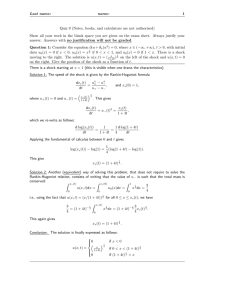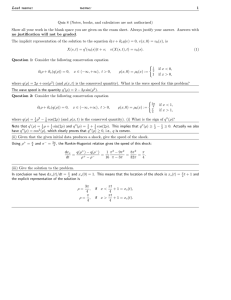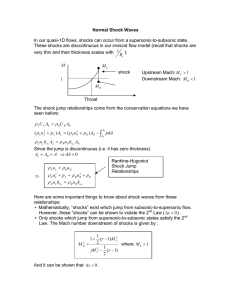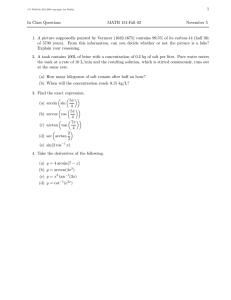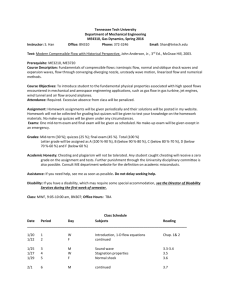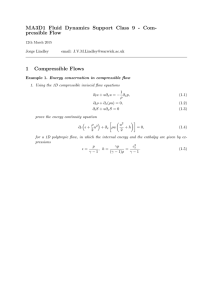Last name: name: 1 Quiz 8 (Notes, books, and calculators are not authorized)
advertisement
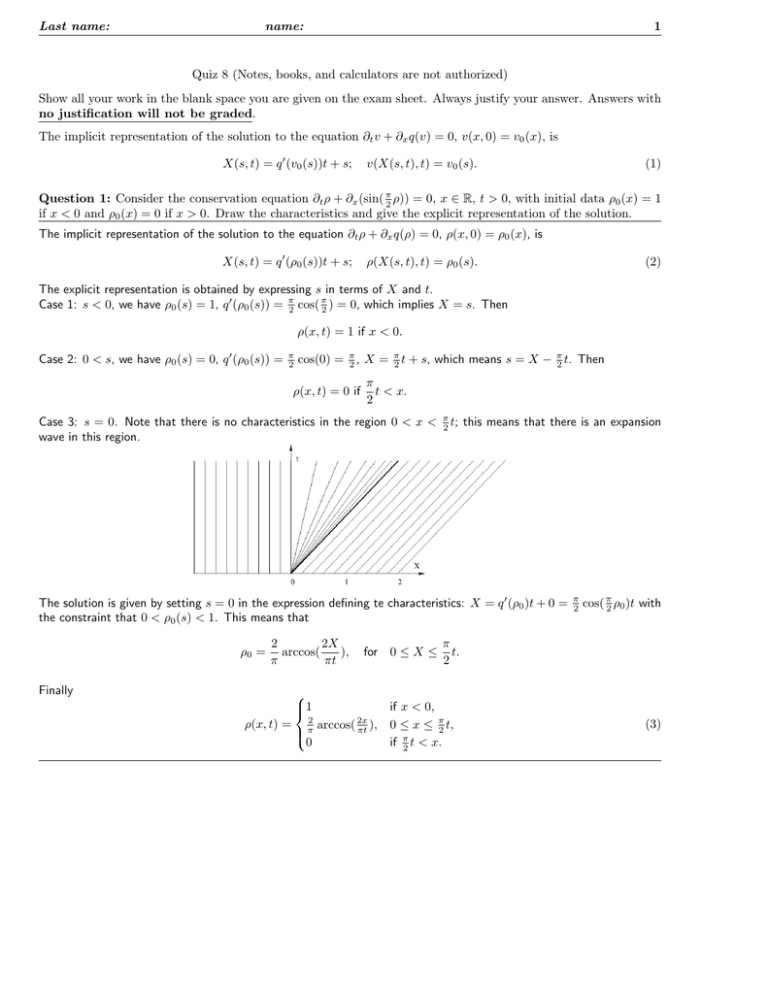
Last name: name: 1 Quiz 8 (Notes, books, and calculators are not authorized) Show all your work in the blank space you are given on the exam sheet. Always justify your answer. Answers with no justification will not be graded. The implicit representation of the solution to the equation ∂t v + ∂x q(v) = 0, v(x, 0) = v0 (x), is X(s, t) = q 0 (v0 (s))t + s; v(X(s, t), t) = v0 (s). (1) Question 1: Consider the conservation equation ∂t ρ + ∂x (sin( π2 ρ)) = 0, x ∈ R, t > 0, with initial data ρ0 (x) = 1 if x < 0 and ρ0 (x) = 0 if x > 0. Draw the characteristics and give the explicit representation of the solution. The implicit representation of the solution to the equation ∂t ρ + ∂x q(ρ) = 0, ρ(x, 0) = ρ0 (x), is X(s, t) = q 0 (ρ0 (s))t + s; ρ(X(s, t), t) = ρ0 (s). (2) The explicit representation is obtained by expressing s in terms of X and t. Case 1: s < 0, we have ρ0 (s) = 1, q 0 (ρ0 (s)) = π2 cos( π2 ) = 0, which implies X = s. Then ρ(x, t) = 1 if x < 0. Case 2: 0 < s, we have ρ0 (s) = 0, q 0 (ρ0 (s)) = π 2 cos(0) = π 2, ρ(x, t) = 0 if X= π 2t + s, which means s = X − π2 t. Then π t < x. 2 Case 3: s = 0. Note that there is no characteristics in the region 0 < x < wave in this region. π 2 t; this means that there is an expansion The solution is given by setting s = 0 in the expression defining te characteristics: X = q 0 (ρ0 )t + 0 = the constraint that 0 < ρ0 (s) < 1. This means that ρ0 = 2 2X arccos( ), π πt for 0≤X≤ π 2 cos( π2 ρ0 )t with π t. 2 Finally ρ(x, t) = 1 2 π 0 arccos( 2x πt ), if x < 0, 0 ≤ x ≤ π2 t, if π2 t < x. (3) 2 Quiz 8, November 25, 2014 Question 2: Consider the following conservation equation ∂t ρ + ∂x (q(ρ)) = 0, x ∈ (−∞, +∞), t > 0, ρ(x, 0) = 12 if x < 0, and ρ(x, 0) = 1 if x > 0. where q(ρ) = 2ρ + 3ρ3 − sin(ρ2 ) (and ρ(x, t) is the conserved quantity). What is the wave speed for this problem? The wave speed is the quantity q 0 (ρ) = 2 + 9ρ2 − 2ρ cos(ρ2 ). Question 3: Consider the conservation equation with flux q(ρ) = ρ4 . Assume that the initial data is ρ0 (x) = 2, if x < 0, ρ0 (x) = 1, if 0 < x < 1, and ρ0 (x) = 0, if 1 < x. (i) Draw the characteristics There are three families of characteristics. Case 1: s < 0, X(s, t) = 32t + s. In the x-t plane, these are lines with slope 1 32 . Case 2: 0 < s < 1, X(s, t) = 4t + s. In the x-t plane, these are lines with slope 14 . Case 3: 1 < s, X(s, t) = s. In the x-t plane, these are verical lines. One shock forms between the two black characteristics and another forms between the two red characteristic (see figure). (ii) Describe qualitatively the nature of the solution. We have two shocks moving to the right. One shock forms between the two black characteristics and another forms between the two red characteristic (see figure). (iii) When does the left shock catch up with the right one? The speeds of the shocks are 24 − 1 dx1 (t) = = 15, dt 2−1 and dx2 (t) 1−0 = = 1. dt 1−0 The location of the left shock at time t is x1 (t) = 15t and that of the right shock is x2 (t) = t + 1. The two shocks are 1 at the same location when 15t = t + 1, i.e., t = 14 .
